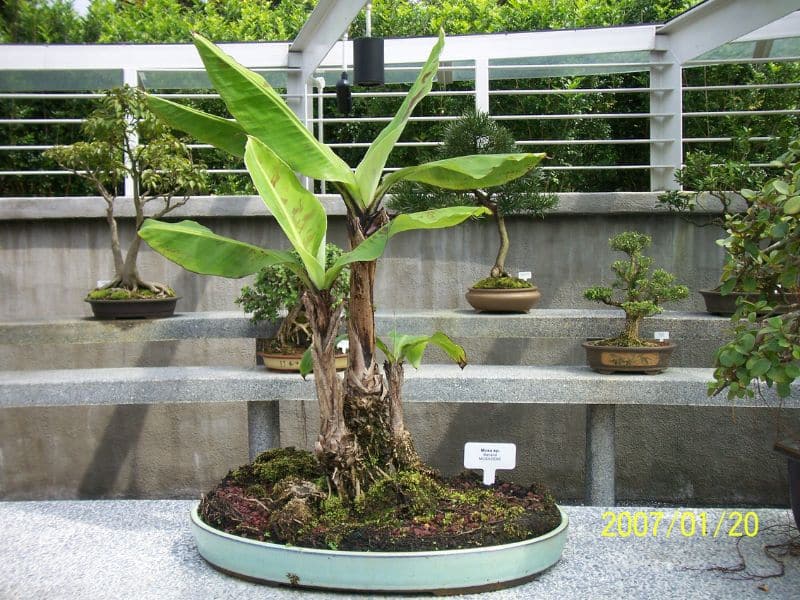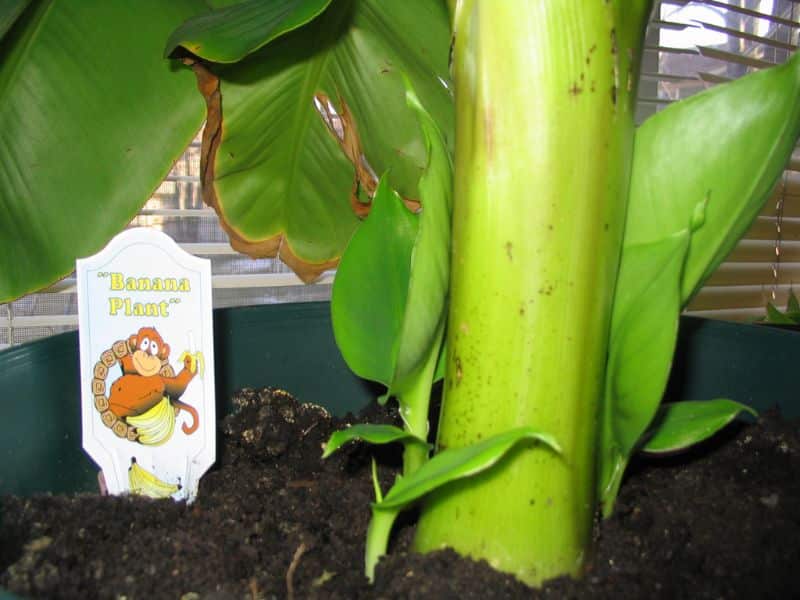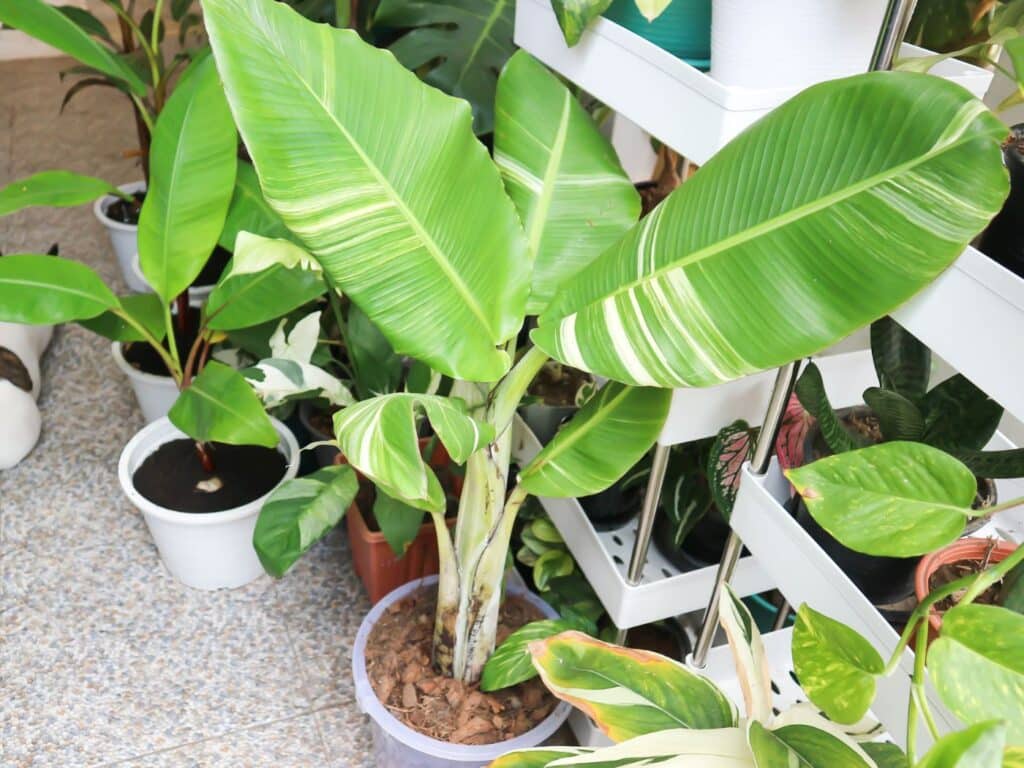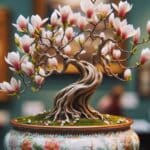A banana bonsai tree (Musa acuminate) is a beautiful plant to grow because they are easy to train and care for. These tiny trees can give your interior spaces a warm and tropical feel, and the ornamental trees can add a lot of bright color with their soft green leaves.
Banana bonsai trees can look charming as individual plantings in a small pot or be grouped together to create a miniature tropical forest vibe.
In this guide, we will share some great tips on how to grow banana bonsai trees and show you how to take good care of this little fruit plant.

Plant Facts
| Scientific name | Musa acuminata |
| Common names | Banana tree, banana bonsai, Cavendish |
| Family | Musaceae |
| Plant Type | Fruit tree |
| Height and Width | 8-10 ft. tall (natural form), 10–100 inch. tall (bonsai form) |
| Origin | Southeast Asia, Indonesia, or the Philippines |
| Flower colors | Purple, maroon, pink, or yellow depending on the variety |
| Foliage color | Light green |
| Sun Exposure | Indirect filtered light |
| Soil Type & pH | Well-drained, loose organic soil mix |
| Special features | Low Maintenance. Good for Containers. Easy to bonsai |
What Does a Bonsai Banana Tree Look Like
A bonsai banana is a miniaturized version of a fully-grown banana tree with large, soft green leaves, a single stem, and no branching. The bonsai plants can bloom or produce fruits, but they can appear oversized on a miniaturized tree since they have full-sized fruits or blooms.
Where Does a Bonsai Banana Tree Grow
The banana plant is a tropical species that prefers warmer temperatures, high humidity, and regular watering. They originate from Southeast Asia but are now grown worldwide in warm and tropical weather.
These ornamental houseplants make good indoor bonsai plants because they are easy to grow and take well to ceramic, wood, or plastic containers.
How to Grow a Bonsai Banana Tree
When you are growing a banana bonsai tree, it is best to select a darf variety. Dwarf banana varieties are naturally smaller, they grow better in containers, and they are easier to bonsai. Let’s look at how to grow and create your banana bonsai tree.
Propagation
There are various ways to propagate a banana tree. They can be propagated by division or tissue culture or grown from seed. Tissue cultivation is very complex, and you will need a laboratory to perform this propagation method. This leaves us with two alternative methods.
Growing from seed
The success rate for growing banana plants from seed is low since most varieties are sterile and don’t produce seeds. Find a banana with seeds inside the fruit and harvest the little black dots. The seeds can be germinated by soaking to soften the seed coat. Sow the seeds of your dwarf banana in a sowing tray, keeping them moist and giving them time. Hopefully, some of those seeds will start to sprout.
Propagation from division
The best way to propagate a banana tree is through division. These trees will grow pups from their rhizomes. If these pups are large enough, they can be cut away from the mother plant and transplanted into a bonsai pot.
Soil
Your banana bonsai tree should be planted in well-draining soil, but this soil should also retain some moisture because the trees need to stay hydrated. You can create your soil mix by mixing equal parts of the following.
- Loam – offers nutrients and structure to the plant.
- Peat Moss – enhances water retention and nourishes the plant.
- Coarse sand or Perlite – enhances the drainage and will keep the plant roots aerated.
Pruning
Banana Bonsai trees should be pruned regularly to keep them small and to encourage more leaf development. These trees only require a little pruning or wiring since they don’t have branches. To prune your tree, you must get a pair of sharp, clean scissors and remove unwanted or overly large leaves.
Only prune the tree a little. Some leaves should always be left over after pruning, or the tree can be damaged.
Repotting and Transplanting
You likely will only need to repot these bonsai plants once every three years, and it is best to do it during early spring. When the bonsai tree is repotted, it should be planted in a slightly larger container with lots of fresh new soil. Removing about one-third of its root system before repotting the plant is also best. Before trimming the roots, washing the banana corm in warm water is best to remove the loose sand.
When you are repotting your plant, you can transplant the new suckers or pups that might have sprouted from the root system.
How To Grow a Bonsai Banana Tree

Once your banana bonsai tree has been planted inside a bonsai container, you only need to ensure that it has enough water and fertilizer. Here are some proper care tips that can ensure healthy growth for your dwarf banana tree.
Water
A banana bonsai tree likes moist soil but its roots can rot if they are kept in waterlogged conditions. It is best to water these plants whenever the top inch of the soil feels dry. It is also recommended to avoid a strict watering schedule and you will need to decrease watering during winter time since the soil will stay moist for longer.
Sunlight
In their natural form, banana trees prefer lots of direct sunlight. On the other hand, the leaves of bonsai banana trees will scorch in direct sunlight. It is best to keep these trees in light, indirect conditions. Place your tree indoors close to a window or use a grow light if the leaves become yellow.
Temperature and Humidity
Banana bonsai prefers warmer climates. Cold weather and scorching direct sun can damage these trees. They typically prefer temperatures of 75 – 95 degrees F. It is best to protect the tree during wintertime. Keep it away from cold drafts and move the tree away from a chilly window during nighttime.
These small trees also love high humidity levels. If you are keeping your plant indoors then it is best to place it in a humidity tree. You can also increase humidity by misting the leaves regularly.
Fertilizer
These small trees will flourish if they receive nitrogen-rich fertilizer. A good fertilizer is something with a 20-20-20 ratio (20% nitrogen, 20% phosphorus, and 20% potassium). This fertilizer will ensure optimal growth and help your tree produce more fruits.
It is best to fertilize the tree weekly during the growing season and to reduce fertilizing during the colder months.
Pest and Diseases
Banana trees can be vulnerable to all sorts of pests. You should regularly inspect your tree for common problems like spider mites, aphids, fruit flies, and scales, and they can become infected with fungal growths. Most of these pests can be treated with organic pesticides, insecticidal soap, or fungicides.
Common Varieties and Cultivars
There are over 1,000 varieties of banana trees, and most of these species get pretty tall. For a bonsai, it is usually best to focus on a dwarf banana variety since they are naturally smaller and bear smaller fruits. Here are some of the top species to grow a small banana tree.
- Dwarf Cavendish
- Dwarf red
- Dwarf Brazilian
- Rajapuri
- Dwarf ladyfinger
- Grain Nain
- Dwarf Jamaican
- William’s Hybrid
Conclusion
It is relatively easy to grow banana tree bonsai, and these plants are easy to care for. The banana plant is a superb selection for a bonsai beginner because they don’t require wiring or training. A dwarf banana can be kept small by keeping it in a small container and regularly pruning the overly large leaves and roots.
We hope you enjoyed our plant growth guide and will enjoy seeing your little tree develop.
Up next: Growing and Caring for a Bonsai Avocado Tree (Persea Americana)
Image by jobrestful/depositphotos







